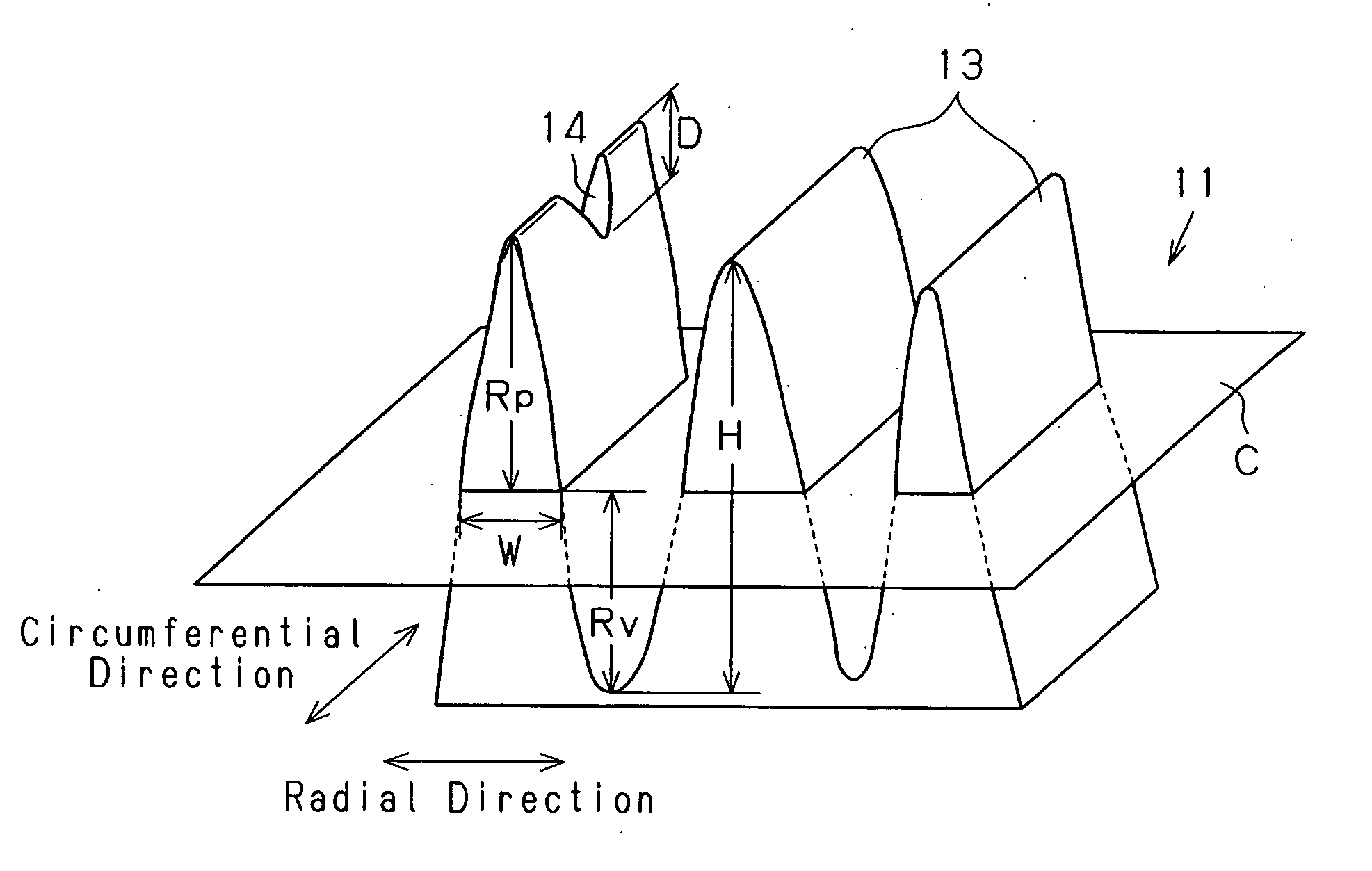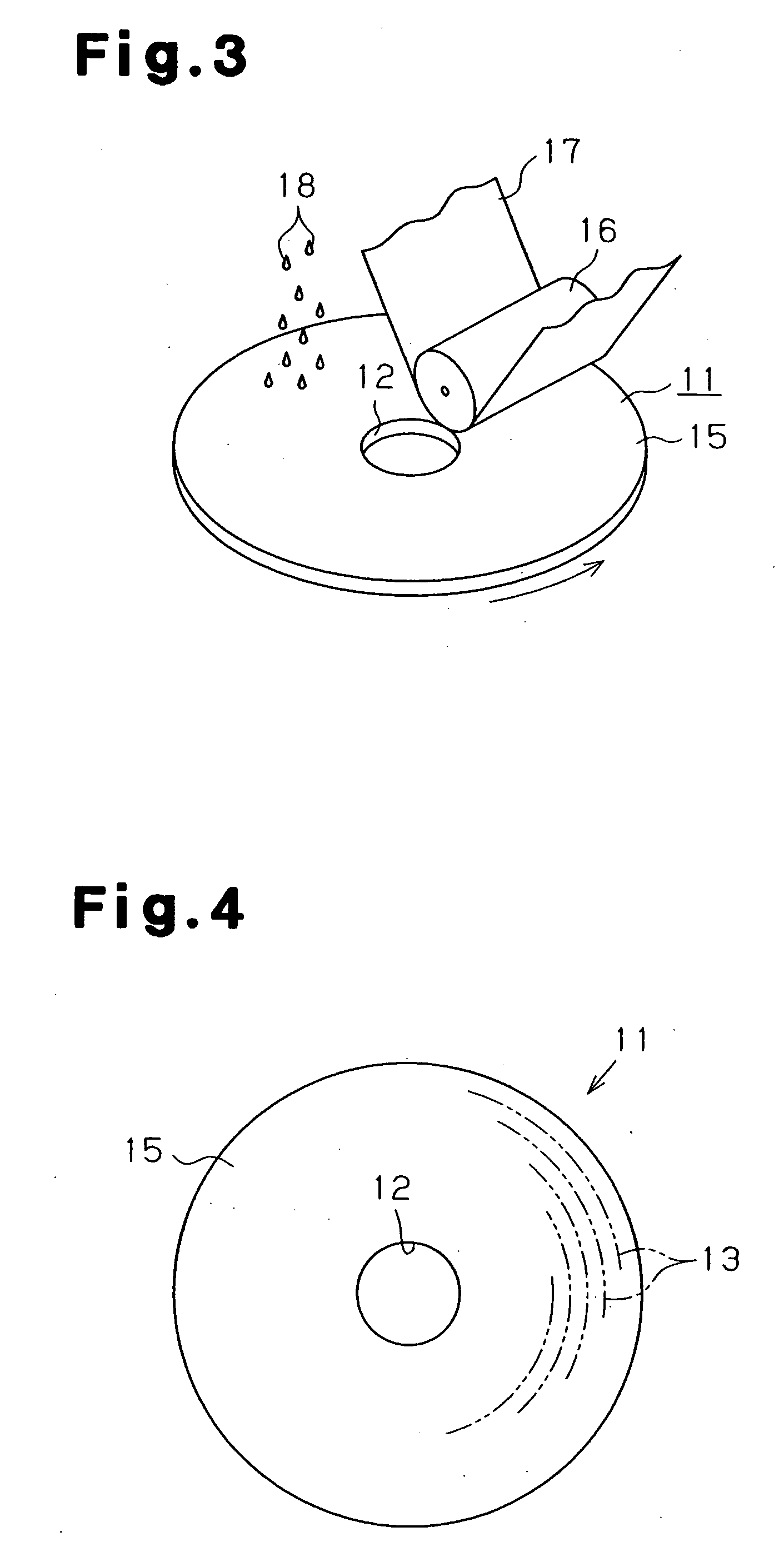Magnetic recording medium glass substrate and method of producing the same
a technology of magnetic recording medium and glass substrate, which is applied in the direction of magnetic materials for record carriers, instruments, transportation and packaging, etc., can solve the problems of insufficient low levitation characteristic and inability to realize the levitation stability of the magnetic head reading information from the glass substrate, and achieve the effect of improving levitation stability and less levitation amount of the magnetic head
- Summary
- Abstract
- Description
- Claims
- Application Information
AI Technical Summary
Benefits of technology
Problems solved by technology
Method used
Image
Examples
example 1
[0096] A sheet of glass substrate 11 formed from aluminosilicate glass (63 mol % of SiO2, 16 mol % of Al2O3, 11 mol % of Na2O, 4 mol % of LiO2, 2 mol % of MgO, 4 mol % of CaO) is obtained through the float process. The glass substrate 11 was machined into a disc shape with a thickness of 1.0 mm, an outer diameter of 65 mm, and an inner diameter of 20 mm using a diamond cutter in the disc machining process 21.
[0097] Subsequently, in the inner and outer circumferential surface chamfering process 22, the inner and outer circumferential surface chamfering was performed on the glass substrate 11. In the main surface polishing process 23, lap polishing and smoothing were performed on the main surface 15 of the glass substrate 11. The smooth polishing was performed by polishing both surfaces of the glass substrate 11 using the polishing agent containing cerium oxide and a polishing pad having an Asker C hardness of 70.
[0098] In the post-polishing washing process 24, after removing the po...
examples 2 to 6
[0108] The manufacturing conditions of the glass substrate 11 were changed as shown in table 1, and a glass substrate having a width W and height H for the texture 13 and a ratio (Rp / RMS) of the maximum mountain height Rp and the root mean square roughness RMS for the texture 13 that are the same as in example 1 was obtained. The continuous seek test and the fixed point levitation test were conducted on the glass substrate in the same manner as in example 1. The results are shown in table 2.
TABLE 2Drive testContin-uousRp / SeekFixed Point LevitationW(nm)H(nm)RMS2000 hr24 hr48 hr72 hr96 hrEx. 11021.5NoNoNoNoNoEx. 21632NoNoNoNoNoEx. 32053NoNoNoNoNoEx. 42064NoNoNoNoYesEx. 55058NoNoNoYesEx. 62001015NoNoNoYesComp.25089YesYesEx. 1Comp.30088YesYesEx. 2Comp.733YesYesEx. 3Comp.61.52YesYesEx. 4Comp.1601.511YesYesEx. 5Comp.2001018YesYesEx. 6
[0109] As shown in table 2, in examples 1 to 3, the width W of the texture 13 was within the range of 10 to 20 nm, the height H of the texture 13 was withi...
examples 7 to 10
[0111] The manufacturing conditions of the glass substrate 11 were changed as shown in table 1, and a glass substrate having an average depth D of the depression 14 and a ratio H / D of the height H with respect to the average depth D of the texture 13 shown in table 3 was obtained in the same manner as in example 1. A continuous seek test and a fixed point levitation test were carried out on the obtained glass substrate 11 in the same manner as in example 1. The results are shown in table 3.
TABLE 3Drive TestContinuousFixed PointSeekLevitationD(nm)H / D2000 hr24 hr48 hr72 hrExample 70.115NoNoNoNoExample 8220NoNoNoNoExample 92.516NoNoYesExample 101.59NoNoYes
[0112] As shown in table 3, in examples 7 and 8, the average depth D of the depression 14 was less than or equal to 2 nm, the ratio H / D was greater than or equal to 10, and crash of the magnetic head did not occur in the continuous seek test and the fixed point levitation test conducted over 72 hours. In example 9, the average depth...
PUM
| Property | Measurement | Unit |
|---|---|---|
| height | aaaaa | aaaaa |
| height | aaaaa | aaaaa |
| width | aaaaa | aaaaa |
Abstract
Description
Claims
Application Information
 Login to View More
Login to View More - R&D
- Intellectual Property
- Life Sciences
- Materials
- Tech Scout
- Unparalleled Data Quality
- Higher Quality Content
- 60% Fewer Hallucinations
Browse by: Latest US Patents, China's latest patents, Technical Efficacy Thesaurus, Application Domain, Technology Topic, Popular Technical Reports.
© 2025 PatSnap. All rights reserved.Legal|Privacy policy|Modern Slavery Act Transparency Statement|Sitemap|About US| Contact US: help@patsnap.com



